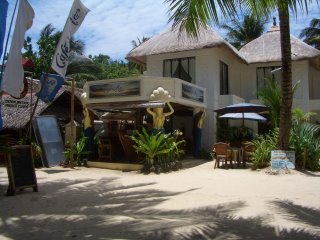A bumpy 1 hour flight from Manila in a prop plane landed me in Caticlan, the closest airport to Boracay. From the tiny airport, a short ride in a "tricycle" took me to the boat station. The tricycles are actually motorbikes with makeshift, covered sidecars attached--the local taxi. They can oft be seen carrying as many as 6 passengers...
From the boat station, its just a 40 cent/15 minute ride to Boracay, where I took another trike and finally arrived at Frendz Resort, one of the hundreds of lodging options on the island. 
Boracay is quite small actually, I think about 7km long--you can sail around it in less than an hour. It is affected by a strange dynamic in that the huge influx of foreign wealth has little physical separation from the local poverty. Mere meters from the poshest resorts and condos, are locals living in shacks and homes made out of anything they can find. A minute's stroll from the main boardwalk (really just a sandy path between the palms/beach and the long, long row of hotels, restaurants, shops, and bars), will find you in a dilapidated neighborhood or next to a swamped basketball court filled with garbage.
The locals are not really locals, but came from other surrounding islands for employment when the money started to roll in. The original inhabitants, for unknown-to-me reasons, were pushed out, or to the inner depths of the island. The few I saw (easily distinguished by their much darker skin) were frail mothers who came down to the boardwalk at night with their infants to sit in front of the nice resorts and beg for money. The locals who do have tourism jobs (cooks, shop managers, bartenders, maids, sailboat captains, sunglass and wristwatch vendors, etc) work for a couple dollars a day which supports their families on Boracay, or on their home islands.
The island is developed, with more resorts and condos and golf courses being built, but it seems only on its edges. The few trips I took across the island reminded me of the countryside in Panama, with people living in relative poverty. Cows, pigs, goats, and chickens are everywhere, a lot of people seem to be doing a whole lot of nothing, and the infrastructure seems rather improvised. No doubt the situation is much more complex than was visible to me, especially as I spent most of my time in the ocean or in the more prosperous margin.
I was there in the low season (read: typhoons), but the resorts and restaurants had a fair number of people anyway. There seemed to be two kinds of locals: those who were polite because they wanted your money but couldnt manage a smile and those who were genuinely friendly. Either way, I have never been called "sir" so many times in my life.
“There is no fun in a thorough understanding of any subject. A domain that naturally contains more mystery than is solvable on any given day, like fishing, is very enjoyable. Such mystery overflows itself.” --Scott Bowen

1 comment:
Sounds like you had a nice time. How did you find out all this info about the economic history of the island? Was it readily available or did you actively go ask around.
Oh yeah, and thanks for bringing the typhoons back with you to Japan. :) And I thought the rainy season had finished.
Post a Comment